
Dice are a vital tool in many tabletop role-playing games and other boardgames. They can be used to create highs and lows, such as a critical hit or a fumble, in the game, and they are also an essential element of narrative.
A traditional die has six faces, each of which is marked with a different number of dots (pips) from one to six. These are usually carved or printed into the die’s material, and when rolled, they show a random integer from one to six on their upper surface.
There are a variety of types of dice, including polyhedral or irregular shapes; ones that have numbers written on them instead of pips; and ones with different faces markings. In addition to being used in traditional games, dice are also widely used in a wide range of other contexts.
In dice-based games, players often use shorthand notations to indicate what kind of roll they are making, such as d4, d6, d8, d12, and d20. These are typically followed by modifiers that indicate how the result should be calculated, such as 3d6+4, which indicates that a player must roll three six-sided dice and add their results to get a total value.
Loaded Dice
In some games, such as Magic: the Gathering and Dungeons & Dragons, certain kinds of dice are designed to favor some results over others for a variety of reasons. These are commonly known as loaded dice or cheat dice.
You can detect cheat dice by examining their weight.
A die’s weight can be determined by testing the numbers on it and notating the bias.
Generally, if a player’s dice are heavily biased towards high numbers, they are cheat dice and should be banned from the game.
If a player has several dice that are loaded in the same way, you should test all of them to see if they’re biased toward high numbers.
However, you should note that a dice’s bias is not always clear.
It’s possible that the player’s dice are not heavily biased and are just poorly balanced, as is the case with a few common spindown die sets.
In this scenario, you should explain to the player why their dice are not evenly balanced and ask them to use a set of fair, unbiased dice.
You can also offer to test the player’s dice.
Dice can be tampered with in a number of ways, ranging from altering the color to changing the shape.
A simple and effective way to cheat a die is by hollowing it out.
To do this, simply approach the die from multiple angles. If you can, try to get every part of the die hollowed out.
Another technique is to insert a tiny weight into one side of the die, such as a nail or lead pellets.
The weight should be inserted as close to the edge of the die as possible.
You can also use super glue to keep the weight in place, and sand it down if it’s too large. This helps to prevent the weight from splaying out of the die and looking different.